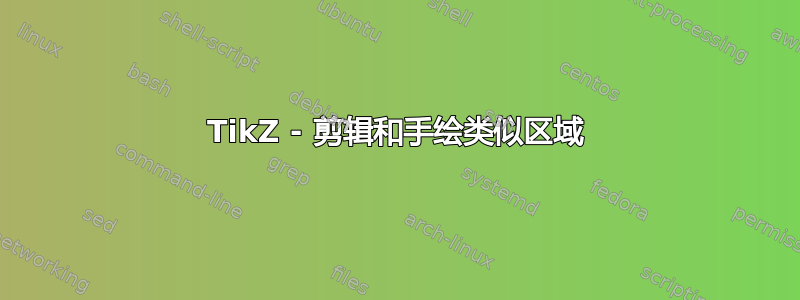
答案1
如果您只需要椭圆的部分填充,可以尝试我的方法。
\documentclass[border=5pt]{standalone}
\usepackage{pgfplots}
\pgfplotsset{compat=newest}
\usepgfplotslibrary{fillbetween}
\begin{document}
\begin{tikzpicture}
\begin{scope}
\clip (0,0) ellipse [x radius=2, y radius=1];
\path[name path=a] (0,0) ellipse [x radius=2, y radius=1];
\path[name path=b] (0,-1) to[out=135, in=315] (0,1);
\draw [fill=cyan!50!white] (0,0) ellipse [x radius=2, y radius=1];
\draw [fill=green!50!black,
intersection segments={
of=a and b,
sequence={L2--R2}
}
];
\begin{scope}
\clip (0,-1) circle[radius=1];
\draw (0,-1) circle[radius=1];
\end{scope}
\end{scope}
\end{tikzpicture}
\end{document}
对于模式,你可以使用patterns或做一些循环,foreach例如
\foreach\i in {-10,-9.75,...,10}{%
\draw[orange] (\i,0) --++ (45:4);
}
在clip和scope环境中
编辑
我尝试了一下之前的例子,现在它应该可以满足您的需求。
\documentclass[border=5pt]{standalone}
\usepackage{pgfplots}
\pgfplotsset{compat=newest}
\usepgfplotslibrary{fillbetween}
\definecolor{mygreen}{RGB}{19,75,46}
\definecolor{myblue}{RGB}{0,103,125}
\definecolor{mypink}{RGB}{135,34,68}
\definecolor{myorange}{RGB}{172,54,18}
\begin{document}
\begin{tikzpicture}[scale=2]
\begin{scope}
\clip (0,0) ellipse [x radius=2, y radius=1];
\draw [name path=a, fill=cyan!25!white] (0,0) ellipse [x radius=2, y radius=1];
\draw[name path=b] (0,-1) to[out=135, in=315] (0,1);
\draw [fill=green!75!black,
intersection segments={
of=a and b,
sequence={L2--R2}
}
];
\foreach\i in {-10,-9.75,...,10}{%
\draw[pink] (\i,-1) --++ (45:4);
}
\begin{scope}
\clip (0,-1) circle[radius=1];
\draw[name path=c, fill=cyan!25!white] (0,-1) circle[radius=1];
\draw[name path=b] (0,-1) to[out=135, in=315] (0,1);
\draw [draw=black,fill=green!75!black,
intersection segments={
of=a and b,
sequence={L2--R2}
}
];
\foreach\i in {-10,-9.75,...,10}{%
\draw[orange] (\i,-2) --++ (135:4);
}
\end{scope}
\end{scope}
\node[fill=white, inner sep=1pt, font=\footnotesize] at (-0.5,0.5) {$\mathrm{\frac{1}{3}h}$};
\node[fill=white, inner sep=1pt, font=\footnotesize] at (0.5,0.5) {$\mathrm{\frac{2}{3}h}$};
\draw (-0.5,0.875) to [out=90, in=90, edge node={node [sloped, above, font=\footnotesize] {$\mathrm{\bar{F}}$}}] (0.5,0.875);
\fill (-0.5,0.875) circle[radius=0.5pt];
\fill (0.5,0.875) circle[radius=0.5pt];
\node[fill=white, inner sep=1pt, font=\footnotesize] at (-0.5,-0.5) {$\mathrm{\frac{1}{4}f}$};
\node[fill=white, inner sep=1pt, font=\footnotesize] at (0.5,-0.5) {$\mathrm{\frac{3}{4}f}$};
\draw (-0.5,-0.875) to [out=180, in=90] (-0.875,-1.125) node[below, font=\footnotesize] {{$\mathrm{T}$}};
\fill (-0.5,-0.875) circle[radius=0.5pt];
\draw (0.5,-0.875) to [out=0, in=90] (0.875,-1.125) node[below, font=\footnotesize] {{$\mathrm{\bar{T}}$}};
\fill (0.5,-0.875) circle[radius=0.5pt];
\path [name path=a] (0,0) ellipse [x radius=2, y radius=1];
\path[name path=d] (-2,0.5) -- (2,0.5);
\path[name intersections={of=d and a},];
\coordinate (P1) at (intersection-1);
\draw (P1) --++ (0.125,0.125) node[right, font=\footnotesize] {{$\mathrm{\Omega}$}};
\fill (P1) circle[radius=0.5pt];
\end{tikzpicture}
\end{document}





